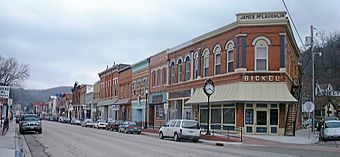McGregor Commercial Historic District facts for kids
Quick facts for kids |
|
|
McGregor Commercial Historic District
|
|
 |
|
| Location | 100-300 blocks of Main St. and the 100 and 200 blocks of A St., McGregor, Iowa |
|---|---|
| Area | 15 acres (6.1 ha) |
| Architect | E.C.W. Jacobs |
| Architectural style | Italianate Greek Revival |
| MPS | Iowa's Main Street Commercial Architecture MPS |
| NRHP reference No. | 02001033 |
| Added to NRHP | December 10, 2002 |
The McGregor Commercial Historic District is a special area in McGregor, Iowa, United States. It's like a time capsule of old buildings that are important to history. This district was officially added to the National Register of Historic Places in 2002. This means it's recognized as a place worth protecting because of its historical value.
When it was listed, the district had 60 important parts. These included 51 buildings that helped tell its story, one special outdoor spot, and one unique structure. There were also seven newer buildings that didn't quite fit the historical period.
Unlike many towns along the Mississippi River in Iowa, McGregor's main shopping area doesn't run right next to the river. Instead, it stretches away from it. The district is long and narrow, following Main Street. This street is nestled in a tight valley between two tall bluffs, which are like cliffs, about 400-foot (120 m) high. The valley eventually opens up to the river.
What Makes McGregor's Buildings Special?
The buildings in this historic district were built over a long time. The oldest ones date back to 1849, and the newest were finished in 1952. Many of the most important buildings were constructed between 1849 and 1860.
A Look at the Architecture
Most of these buildings are made of brick and stand one to three stories tall. They often show off two popular styles of architecture from the past. One is the Italianate style, which often features tall, narrow windows and decorative details. The other is the Greek Revival style, which looks a bit like ancient Greek temples with grand columns and simple, strong shapes.
You can also find a few buildings made of stone, wood, or even logs. A local architect named E.C.W. Jacobs designed some of the important buildings here. These include the First National Bank (built in 1863), the Town Hall and Jail (from 1874), and a block of buildings at 128-134 Main Street (from the 1880s).
Famous Buildings and Features
Some buildings in the district are so important that they have their own special listings on the National Register. These include the American House, built in 1854, which was likely a hotel or inn. Another is the Joseph "Diamond Jo" Reynolds Office Building and House from 1885, belonging to a famous steamboat owner. The Goedert Meat Market, built in 1890, is also individually recognized.
Beyond the buildings, there are other interesting parts of the district. Market Square, a park, is considered a "contributing site" because it's an important part of the area's history. Even the main storm sewer line is recognized as a "contributing structure," showing how different parts of a town's development can be historically significant.



